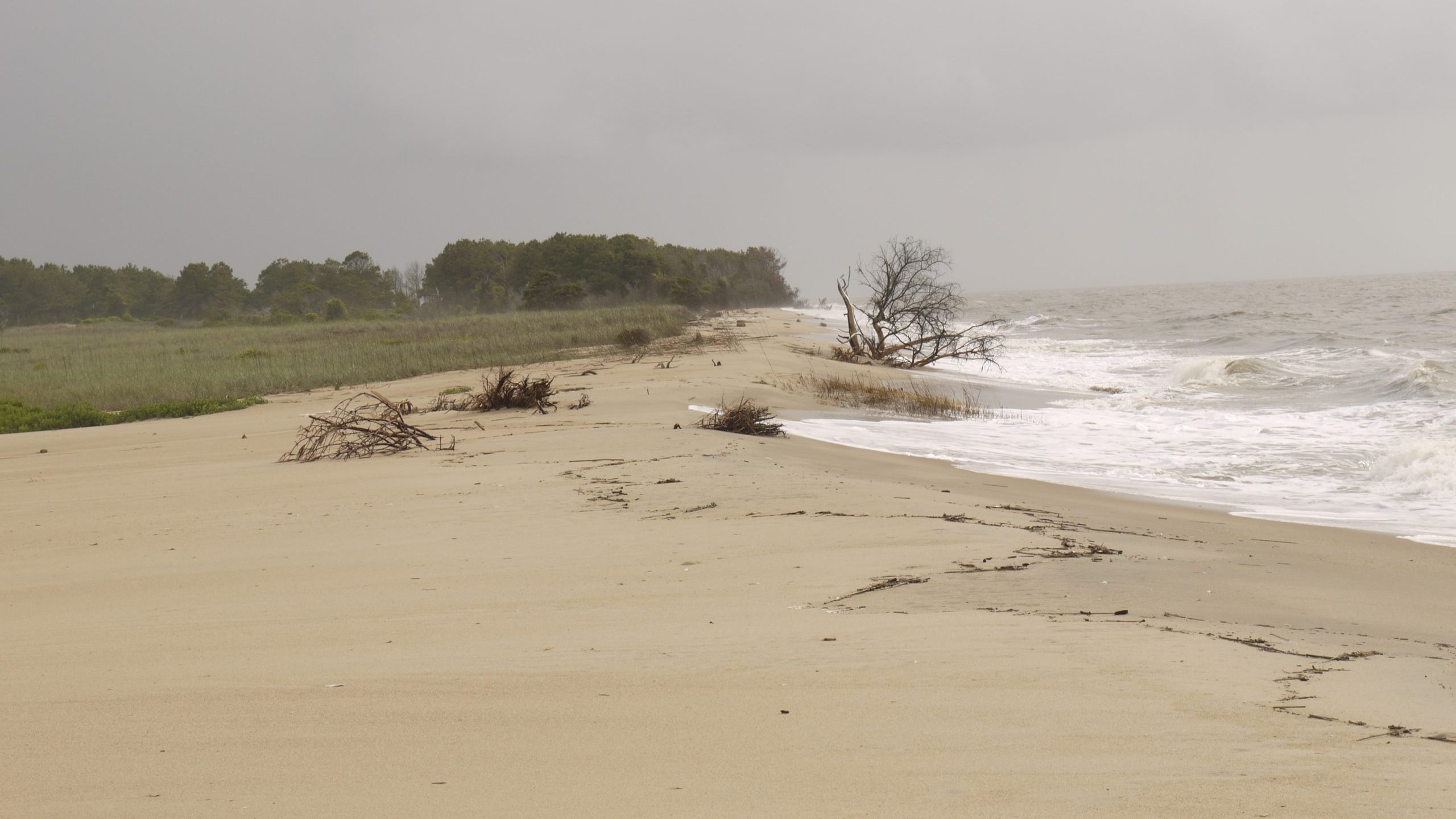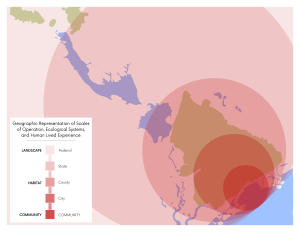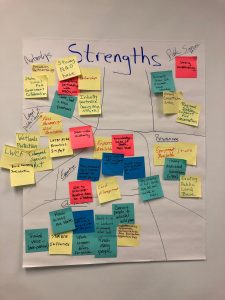Partnership Enables Climate Change Adaptation for Coastal National Wildlife Refuges

A team of SE CASC researchers led by SE CASC Research Ecologist, Mitch Eaton, published Cape Romain Partnership for Coastal Protection: U.S. Geological Survey Open-File Report 2021–1021, available June 8, 2021. The report summarizes work supported by SE CASC project, Climate Change Adaptation for Coastal National Wildlife Refuges. Abstract and select images from report follow.

This final report summarizes activities, outcomes, and lessons learned from a 3-year project titled “Climate Change Adaptation for Coastal National Wildlife Refuges” with the Cape Romain National Wildlife Refuge (NWR) and local partners in the surrounding South Carolina Lowcountry. The Lowcountry is classified as the 10-county area encompassing the coastal plain of South Carolina (this report specifically focuses on Berkeley, Charleston, and Georgetown Counties). The goals of this work, sponsored by the U.S. Geological Survey’s Southeast Climate Adaptation Science Center (SECASC), were to foster active engagement with stakeholders; to develop a comprehensive definition of adaptation problems faced by agencies, organizations, and individuals near the Cape Romain NWR that accounts for global change, local values, knowledge and perceptions; and to encourage social learning and building of effective networks and trust across South Carolina Lowcountry organizations and individuals. Although project scoping began at the scale of the Atlantic seaboard, by engaging with NWRs from Massachusetts to Florida, participating refuge personnel eventually selected the Cape Romain NWR to serve as a case study for testing our goals. The Cape Romain Partnership for Coastal Conservation was established to address global change impacts at a regional level and includes representation from Federal and State resource agencies, local conservation nongovernmental organizations, and organizations representing underserved community interests. Research topics, originating from discussions with Cape Romain Partnership for Coastal Conservation members, focused on quantifying key drivers of change including localized sea-level rise (SLR) predictions, estimates of coastal hurricane inundation as amplified by SLR, and urban growth trends and forecasts. These key drivers provided a foundation to engage stakeholders in planning exercises to begin a process of collective understanding and collaborative decision making. The goal of this process was to develop collective strategies of adaptation to enhance community and ecosystem resilience in the South Carolina Lowcountry.
South Carolina’s Lowcountry is experiencing rapid environmental and social transformation because of SLR rates approaching twice the global average, chronic tidal flooding and catastrophic storm surges, erosion and loss of habitats that provide essential services to wildlife and humans, and increasing social polarization fueled by aggressive low-density urban growth and other forms of land conversion. To support characterizations of plausible future scenarios, we used available or, in some cases, developed new models to project future conditions of key environmental and social-economic drivers. Because of the imprecision of mean global SLR projections, the SECASC commissioned a climatological study to account for local conditions and multiple representative concentration pathways to project a tailored distribution of future sea levels. These projections were matched to SLR scenarios provided by existing models to anticipate the range of future coastal habitat changes in the South Carolina Lowcountry. SLR scenarios were also incorporated into existing storm-surge models, which do not account for alternate baseline sea levels, to project the local effects of future hurricanes. To evaluate the extent and effects of population growth and urban expansion, we relied on an existing urban-growth model to map the spatial distribution of land-conversion probabilities, the total area of which is predicted to increase twofold to threefold over the next 60 years. In addition to this simplified model, an econometric model is in development to account for nonlinear feedback dynamics in land value, land use, and ecosystem service production. Although not yet completed, the goals of this model are to produce more-detailed projections of growth dynamics and to allow predictions of development patterns resulting from alternate land-use planning policies and incentives.

Collaborative planning for an uncertain future requires more than providing decision makers with information on future physical and ecological conditions; developing effective and consensual strategies must also integrate sociological values, multiple cultural perspectives, and an understanding of human behavior. To support broad stakeholder engagement in integrative approaches to adaptation planning, emphasis was placed on the importance of considering differences in how individuals perceive their environment and create meaning. Because cultural frameworks form the basis for perceptions and, ultimately, the behaviors of individuals and institutions, we describe a model of human behavior and how it can be used to understand the effect of cultural complexity and variation in perception on choices, behavioral change, and long-term maintenance of behaviors. We consider a model commonly used in the field of behavioral health that accommodates variation in human perception when describing stages of behavior and the dynamics of behavioral change. Tailoring communication and engagement activities to targeted stakeholders is likely to benefit from increased understanding of behavioral change processes.
The complex nature of this problem limited the usefulness of a traditional decision-analytic approach, we explored alternative methods for engagement, collaborative learning and decision making. Recognizing that project partners and Lowcountry stakeholders may be at different stages of preparedness and interest level for modifying behavior as a function of global change, we facilitated a scenario-planning exercise to familiarize partners with this well-established approach for communicating the opportunities and threats arising under alternative, plausible futures. We developed narratives for four alternative South Carolina Lowcountry scenarios to be used in later strategic planning that focus on quantitative trends for three primary drivers with high impact and high uncertainty: manifestations of climate change, social-political shifts at a global level, and forces of local value and power structures. This scenario-planning exercise underscored the complex relation between the temporospatial scale of the production of ecological goods and services and the institutional scale at which they are managed. We then guided the partners through an assessment of the relevant strengths and weaknesses of the Cape Romain Partnership for Coastal Protection, using the threats and opportunities characterized by each scenario to understand how the partnership might respond when attempting to meet conservation and societal objectives. The partnership identified key strengths including partnership experience, outreach and technical capacities, a substantial conservation land base, and high social cohesion in the South Carolina Lowcountry. Limited communication expertise, institutional inertia, and insufficient staffing and funding were recognized as important weaknesses across the partnership. By examining and scoring combinations of internal strengths and weaknesses and external threats and opportunities, the partnership developed sets of prioritized strategies to consider in the context of a given scenario. Although we had insufficient time to examine all scenarios in detail, the intent was to identify a portfolio of strategic actions to address threats and opportunities represented in multiple plausible futures. Top-ranking strategies encompassed a range of actions that focused on strengthening the conservation community and communicating the benefits of nature (that is, ecosystem services) to leveraging partnerships to expand land protection.
This report also details the methods and preliminary results of several models developed or applied in support of this project. Two parcel-selection algorithms were used to evaluate anticipated habitat changes and patterns of urban growth to guide decisions on optimal conservation reserve design to protect habitat communities. One approach used a widely available planning software (MARXAN) to maximize conservation benefits near the Cape Romain NWR, whereas the other approach was a novel application of economic theory to account for uncertainty in future conditions and for the risks of unanticipated habitat loss. This latter model applies modern portfolio theory to estimate the risk of investing in any portfolio of land parcels (that is, candidate “reserves”) under climate-change uncertainty by quantifying the variation and spatial correlation of conservation benefits derived from each portfolio. We expanded the range of actions beyond simply whether or not to invest in a set of land parcels, an approach commonly used in spatial conservation planning, to also include consideration of divestment from currently protected lands. Such refinements allow for better accounting of system dynamics and can evaluate the benefits of flexible conservation tools such as rolling easements. Model results were conditional on a decision maker’s risk tolerance but highlighted general strategies of land conservation to increase future habitat representation beyond what is expected under the current protected land base. We built models that may help inform coastal planning by estimating salinity dynamics and the performance of oyster reef restoration efforts to predict the combined effects of global change and management of freshwater flows on coastal habitats and the processes that contribute to their resilience. These models can support restoration decisions by evaluating the expected benefits of site locations for shoreline protection and fisheries production. Lastly, we developed a spatially explicit economic model that predicts feedback dynamics among land value, land-use change, and effects on ecosystem service provision to explore zoning policies and incentives on urban growth and ecosystem services.

We summarize these efforts with insights and considerations for the Cape Romain Partnership for Coastal Protection to continue to engage stakeholders in effective adaptation planning. First, notions of place attachment (referred to as sense of place), and the role of culture in social discourse are increasingly being used to understand the complex interactions between society and the environment and how societies respond and adapt to climate change. Sense of place was a unifying theme whenever the future of the South Carolina Lowcountry was discussed. The contribution of the South Carolina Lowcountry’s environmental wealth, rich cultural heritage, and quality of life to sense of place has important implications for how adaptation planning might best be pursued. More community-based governance of the commons (in other words, natural and cultural resources held in common), in which broad stakeholder participation and power sharing are key elements, is considered important. This devolution of governance is characterized by polycentric institutions and self-organizing social networks that promote a local culture of knowledge sharing, problem solving, and learning. These so-called bridging organizations (or individuals) often provide the leadership necessary to bring together potentially disparate Government agencies and institutions, private organizations, and individuals in a collective process of problem solving. Our observations also suggest that the conservation community in the South Carolina Lowcountry views its activities as integral to the broader governance of social-ecological systems, in which responses to the forces of global change are mediated through culture, economics, and politics. Rather than directly competing with other interests, the South Carolina Lowcountry conservation community seems to embrace an interpretation of conservation in which the fundamental objective is the quality of human life rather than environmental protection.
Fundamental to the types of governance reforms described above is the notion of coproduction, in which experts and users collaborate to develop a shared body of knowledge. In this approach, scientists work with stakeholders to help frame questions, design research, and collect and analyze data. Such sustained collaborations are increasingly believed to be an effective way to produce useable (or actionable) science. The emphasis on social learning, leveraging strong social networks, coordinating and deliberating among diverse stakeholders, and applying principles of adaptive management is an essential contribution to adaptive capacity. The diverse and robust set of scientific approaches, methods to help stakeholders collaborate in effective and goal-driven planning processes, and decision tools resulting from this project hopefully will assist Cape Romain NWR and its partners prepare for climatic, ecological, and social changes over the coming decades.
Suggested Citation
Eaton, M.J., Johnson, F.A., Mikels-Carrasco, J., Case, D.J., Martin, J., Stith, B., Yurek, S., Udell, B., Villegas, L., Taylor, L., Haider, Z., Charkhgard, H., and Kwon, C., 2021, Cape Romain Partnership for Coastal Protection: U.S. Geological Survey Open-File Report 2021–1021, 158 p., https://doi.org/10.3133/ofr20211021.
More Project Information:
- Categories:
